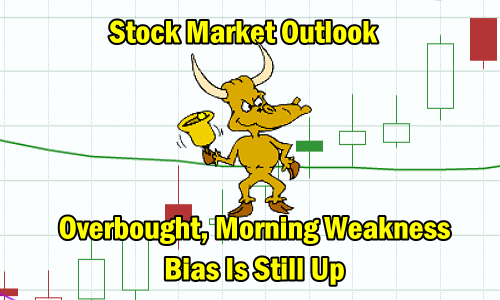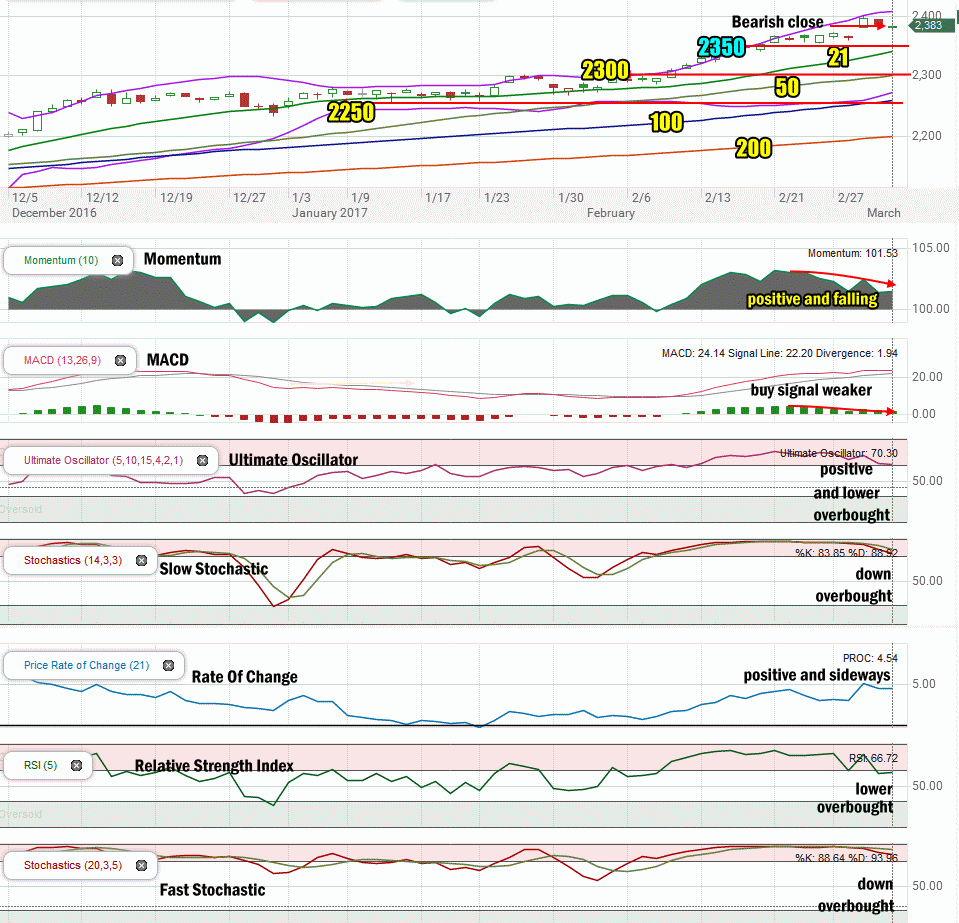 On Friday Mar 3 2017, the biggest event probably came from the Federal Reserve where comments seemed to cement the possibility that interest rates would rise in two weeks when the Fed decision on interest rates was expected March 14-15. The morning saw weakness but when banks, which had been falling earlier, turned around and started to climb higher, stocks followed and ended higher in what had started as a losing session.
On Friday Mar 3 2017, the biggest event probably came from the Federal Reserve where comments seemed to cement the possibility that interest rates would rise in two weeks when the Fed decision on interest rates was expected March 14-15. The morning saw weakness but when banks, which had been falling earlier, turned around and started to climb higher, stocks followed and ended higher in what had started as a losing session.
Let’s look at the closings on Friday and then take a technical overview.
S&P Index Close
The S&P index ended the day up just 1.2 points to close at 2383.12.
Dow Jones Index Close
The Dow Jones ended up 2.74 points to close at 21,005.71 after falling below 21,000 in the morning.
NASDAQ Index Close
The NASDAQ closed up 9.53 points to end the day at 5,870.75.
Stock Market Outlook

Stock Market Outlook Review Of Mar 3 2017
Chart Comments At The Close:
On Friday the S&P traded inside the Upper Bollinger Band and left behind a bearish closing candlestick.
The Lower Bollinger Band which fell below the 50 day moving average has stopped its descent though and is back moving toward the 50 day simple moving average (SMA) which if it crosses up and over it is a bearish signal for the market.
The major moving averages are all still climbing which is bullish.
Stock Market Outlook: Technical Indicators:
Momentum: For momentum I use a 10 period when studying market direction. Momentum is positive and falling.
MACD Histogram: For MACD Histogram, I am using the Fast Points set at 13, Slow Points at 26 and Smoothing at 9. MACD (Moving Averages Convergence / Divergence) issued a buy signal Feb 10 2017. The buy signal lost some strength on Friday.
Ultimate Oscillator: The Ultimate Oscillator settings are: Period 1 is 5, Period 2 is 10, Period 3 is 15, Factor 1 is 4, Factor 2 is 2 and Factor 3 is 1. These are not the default settings but are the settings I use with the S&P 500 chart set for 1 to 3 months. The Ultimate Oscillator is positive and falling. It is overbought.
Slow Stochastic: For the Slow Stochastic I use the K period of 14 and D period of 3. The Slow Stochastic tries to predict the market direction further out than just one day. The Slow Stochastic has a down signal in place and is overbought.
Rate of Change: Rate Of Change is set for a 21 period. This indicator looks back 21 days and compares price action from the past to the present. The rate of change signal is positive and sideways which would indicate prices are not expected to change on Monday.
Relative Strength Index: The relative strength index is set for a period of 5 which gives it 5 days of market movement to monitor. It often is the first indicator to show an overbought or oversold signal. RSI is extremely overbought and pulling back. It is still at readings that almost always signal a pullback or dip should be expected at any time.
Fast Stochastic: For the Fast Stochastic I use the K period of 20 and D period of 5. These are not default settings, but settings I use for the 1 to 3 month S&P 500 chart when I have it set for daily views. The Fast Stochastic has a down signal in place and is also overbought.
Support Levels To Be Aware Of:
The market has light support at the 2250 level. There is also light support at 2195 but better support is at 2180 and then 2150.
Stock Market Outlook for Tomorrow – Monday Mar 6 2017
The technical indicators for Monday are weaker but still, all are positive. For this reason the market will probably be weak again on Monday especially in the morning.
Some of the positive numbers although weaker, still have strong up signals in place which indicates not much change is expected in the market outlook.
For Monday the morning looks weak but for the afternoon and close a positive ending should be in the works.
Stay FullyInformed With Email Updates
Market Direction Internal Links
Profiting From Understanding Market Direction (Articles Index)
Understanding Short-Term Signals
Market Direction Portfolio Trades (Members)
Market Direction External Links
IWM ETF Russell 2000 Fund Info
Market Direction SPY ETF 500 Fund Info
